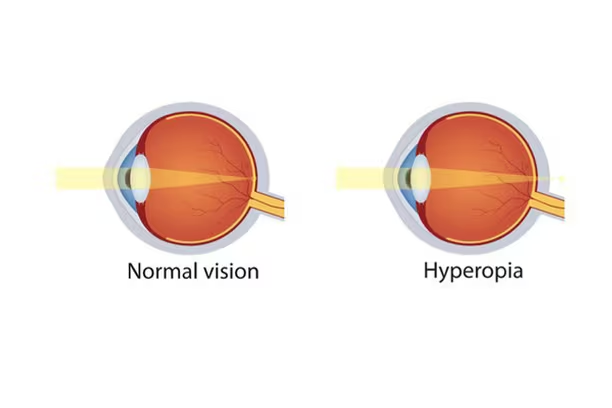When Near Vision Feels Like a Strain
Hyperopia, also known as farsightedness, is a common refractive error where distant objects are seen more clearly than nearby ones. While some people with mild hyperopia may not notice it, others may experience eye strain, headaches, or difficulty reading, especially as they get older.
At London Eye & Retina, we understand that good vision isn’t just about what you can see on a chart, it’s about how comfortable and clear your sight feels throughout your daily life.
What Is Hyperopia?
Hyperopia occurs when the eyeball is too short or the cornea is too flat, causing light rays to focus behind the retina instead of directly on it. This makes near vision more challenging.
Children are often born with a degree of hyperopia that may reduce with age. However, for some, it persists into adulthood. In others, it may only become noticeable when the natural lens loses focusing power with age (presbyopia).
What Causes It?
Hyperopia can be caused by:
- Shorter axial length of the eye
- Flatter-than-normal cornea or lens
- Family history of farsightedness
It may be present from birth and often runs in families. In some cases, it is detected only during routine eye screening, especially if the person’s eyes are compensating well.
Symptoms of Hyperopia
Symptoms can vary depending on the degree of hyperopia and your age. Common signs include:
- Difficulty with reading or near tasks
- Blurry vision, especially at close range
- Eye strain or fatigue
- Headaches after prolonged near work
- Squinting to see clearly
- Discomfort or avoidance of reading in children
In children, uncorrected hyperopia may also be associated with lazy eye (amblyopia) or eye misalignment (strabismus) if not managed early.
How Is It Diagnosed?
Hyperopia is diagnosed through a routine eye exam. At London Eye & Retina, we conduct:
- Visual acuity testing for distance and near vision
- Refraction testing to determine the exact prescription
- Cycloplegic refraction in children to relax the focusing muscles for accurate results
- Slit-lamp and fundus examination to assess the overall health of the eye
We also check for any signs of eye strain or binocular vision problems, especially in younger patients.
Management Options
There are several effective ways to manage hyperopia, depending on your age, lifestyle, and vision needs:
- Spectacles – provide clear and comfortable vision for near and distance
- Contact lenses – an alternative to glasses, offering wider fields of view
- Refractive surgery – such as LASIK or TransPRK, for suitable adults with stable prescriptions
- Bifocal or multifocal lenses – for older adults who also need correction for reading
In children, timely correction is important to prevent long-term visual development issues.
Does Hyperopia Worsen Over Time?
Mild hyperopia in children can decrease as the eye grows. However, in adults, focusing on near objects becomes more difficult with age due to presbyopia, a natural stiffening of the lens. This can make pre-existing hyperopia more noticeable, especially after age 40.
Routine eye exams help detect these changes early so that your prescription can be updated as needed.
Why It’s Worth Checking
Even if your distance vision is clear, untreated hyperopia can lead to chronic eye strain, especially for those doing long hours of screen work or reading. In children, early detection is key to supporting proper vision development and avoiding complications.
Clearer Vision, Less Strain
If reading feels tiring, or your child avoids near tasks, it might be time for a check-up. With the right prescription and care, hyperopia can be managed comfortably and effectively.
Book an eye examination at London Eye & Retina and let us help you see clearly, up close and at a distance.
Comfortable Sight Starts with the Right Diagnosis


